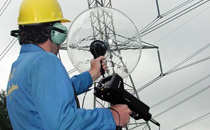Electrical application
-
Partial discharge (tracking) in FFT view
Partial discharge or Tracking occurs where there is a low current pathway to ground across an insulator. There is a buildup and discharge of the voltage that produces “popping” sounds. In FFT we may, but not necessarily, notice several 50Hz amplitudes confirming it is a sound of electrical nature.
-
Partial discharge (tracking) in Time Series view
Partial discharge or Tracking occurs where there is a low current pathway to ground across an insulator. There is a buildup and discharge of the voltage that produces “popping” sounds. The discharge peaks correspond to the “popping” sounds. They are not uniformly spaced in time.
-
Corona in FFT view
Corona is where the pathway to ground is through the air. This type of discharge has a buzzing or frying sound that is uniform. You will note the harmonic peaks at 50Hz are evenly distributed throughout the screen.
-
Corona in Time Series view
The amplitude peaks in the Time Series are equally spaced as the discharges only occur at the negative peak of the sine wave.
-
Arcing in FFT view
With Arcing, the discharge fase to ground is a high current pathway across an insulator. This is a “burst of energy” that has a long duration discharge. The “buzzing” sound that is heard with corona and the initial stages of tracking is not heard with arcing. In FFT we may, but not necessarily, notice several 50Hz amplitudes confirming it is a sound of electrical nature.
-
Arcing in Time Series view
With Arcing, the discharge fase to ground is a high current pathway across an insulator. This is a “burst of energy” that has a long duration discharge. The “buzzing” Sound that is heard with corona and the initial stages of tracking is not heard with arcing. The “burst of energy” will be seen as wide peaks in the time series.







